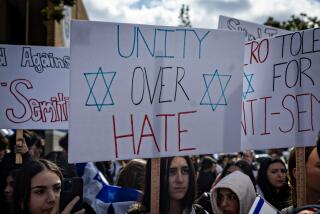Race, gangs divide chief, sheriff
- Share via
Los Angeles’ two top lawmen are increasingly at odds over the extent to which gang violence is being fueled by racial hatred.
Police Chief William J. Bratton and his top deputies have long cautioned that race-motivated violence remains fairly rare and that gang feuds over turf and drugs are the leading cause of such violence.
But over the last few months, Sheriff Lee Baca has publicly voiced a more ominous view of violence between Latino and black gangs. This week, he went further than ever, saying in a Los Angeles Times opinion piece that “some of L.A.’s so-called gangs are really no more than loose-knit bands of blacks or Latinos roaming the streets looking for people of the other color to shoot.”
Baca’s comments have prompted debate in law enforcement circles -- with some Los Angeles Police Department officials questioning some of his assertions.
“The sheriff is saying we need to examine this issue in the light of day to keep it from spreading because we won’t be able to address or reverse it, if we deny it,” said civil rights attorney Connie Rice. “Chief Bratton is saying something equally valid, which is if you overemphasize race, you may be pouring jet fuel on the fire.”
Baca, in an interview Thursday, said he was speaking out because he considers racial animus among various gangs a serious problem that is not being discussed enough. He acknowledged that the Sheriff’s Department doesn’t have statistics showing a major rise in race-related violence but believes it is a growing problem. Baca this week announced that his department would create a Gang Emergency Operations Center to better deal with such violence.
“We need to talk about this in a more public way,” Baca said, adding he had heard about the tension from community activists, beat cops, gang intervention officers and deputies who guard the county’s jails. “It’s a small percentage but a significant percentage.”
But LAPD Deputy Chief Charlie Beck said he disagreed with Baca’s conclusions about race and gang violence.
Beck, who heads the department’s anti-gang efforts and homicide detectives, said race is a major factor in the violence in county and state prisons, and is a problem on school campuses. But, he said, Baca was wrong to say that those factors are at play with gangs on the streets.
“His reality is largely formed by what is happening in the jails,” Beck said. “But I think you have to look at violence on several different levels. . . . In the world of serious gang crime in the city -- which accounts for the vast majority of gang activity in the county -- race is not the primary factor. Are there isolated instances? Yes. But are gang members commonly going around to kill and harm people because they are another race? Absolutely not.”
A Times examination of slayings in 2007 largely backed Bratton’s assertion about the racial factor in gang killings. The Times analyzed the circumstances of 562 Latino and black homicides from 2007 in which the race of the suspects was known, including all LAPD and sheriff’s cases, plus those of smaller police agencies such as Long Beach and Inglewood. The analysis found that nearly 90% of both black and Latino homicide victims had been killed by suspects of their own race.
The issue has been particularly sensitive for Bratton and his command staff in recent months.
Faced with a serious rise in the homicide rate in the early part of the year and several high-profile killings, Bratton, Beck and others battled media reports and public perception that the violence was racially motivated. In one instance, Bratton angrily confronted a television news reporter who challenged the chief’s stance on the issue. Bratton’s assertion that the high number of killings was an anomaly has been largely borne out as the homicide rate has fallen significantly in recent months.
“It’s important that people be well informed when they are forming their opinions about crime in the city,” Beck said. “What we don’t want to happen is for them to draw conclusions that then become the reality.”
Baca said there is a strong perception in the community about growing racial tensions that must be addressed.
“The question is not how often, but why this has happened,” he said. “We don’t need piles of bodies to make the point that this is happening.”
Baca, who oversees the Los Angeles County jails, said he has been dealing for years with violence -- including several major riots -- involving black and Latino gang members.
Indeed, some activists concerned about brown-on-black violence have cited several high-profile incidents that have sparked widespread fear.
Federal prosecutors last year charged members of a Latino gang with conducting a violent campaign to drive blacks out of the unincorporated Florence-Firestone neighborhood, which allegedly resulted in 20 homicides over several years. In the Harbor Gateway area of Los Angeles, police launched a crackdown last year on another Latino gang accused of targeting blacks, including 14-year-old Cheryl Green, whose death became a rallying point.
Rice said that although Baca and Bratton are looking at black-Latino violence through a different set of lenses, they are both correct in how they view the problem.
The sheriff is looking at high-profile but scattered cases of violence in which race was a motive and is saying “something must be done to address it immediately,” Rice said. But Bratton doesn’t want police to create a self-fulfilling prophecy by stoking fears of racially motivated violence, she said.
In essence, Bratton and Baca are warning about two dangers of the same issue, one of overplaying it, and the other of underplaying it, Rice said.
--
More to Read
Sign up for Essential California
The most important California stories and recommendations in your inbox every morning.
You may occasionally receive promotional content from the Los Angeles Times.











